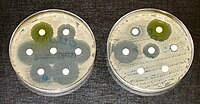
Photo from wikipedia
Both, antibiotic persistence and antibiotic resistance characterize phenotypes of survival in which a bacterial cell becomes insensitive to one (or even) more antibiotic(s). However, the molecular basis for these two… Click to show full abstract
Both, antibiotic persistence and antibiotic resistance characterize phenotypes of survival in which a bacterial cell becomes insensitive to one (or even) more antibiotic(s). However, the molecular basis for these two antibiotic-tolerant phenotypes is fundamentally different. Whereas antibiotic resistance is genetically determined and hence represents a rather stable phenotype, antibiotic persistence marks a transient physiological state triggered by various stress-inducing conditions that switches back to the original antibiotic sensitive state once the environmental situation improves. The molecular basics of antibiotic resistance are in principle well understood. This is not the case for antibiotic persistence. Under all culture conditions, there is a stochastically formed, subpopulation of persister cells in bacterial populations, the size of which depends on the culture conditions. The proportion of persisters in a bacterial population increases under different stress conditions, including treatment with bactericidal antibiotics (BCAs). Various models have been proposed to explain the formation of persistence in bacteria. We recently hypothesized that all physiological culture conditions leading to persistence converge in the inability of the bacteria to re-initiate a new round of DNA replication caused by an insufficient level of the initiator complex ATP-DnaA and hence by the lack of formation of a functional orisome. Here, we extend this hypothesis by proposing that in this persistence state the bacteria become more susceptible to mutation-based antibiotic resistance provided they are equipped with error-prone DNA repair functions. This is - in our opinion - in particular the case when such bacterial populations are exposed to BCAs.
Journal Title: Frontiers in Cellular and Infection Microbiology
Year Published: 2022
Link to full text (if available)
Share on Social Media: Sign Up to like & get
recommendations!